
HOME
INTRO
SYMBOLS
ALMANAC
ECONOMY
GEOGRAPHY
STATE MAPS
PEOPLE
FORUM
NEWS
COOL SCHOOLS
STATE QUIZ
STATE LINKS
BOOK STORE
MARKETPLACE
GUESTBOOK
CONTACT US


You may double left-click on a word on this page to retrieve its definition. Tweet Follow
Tennessee State Wild Flower
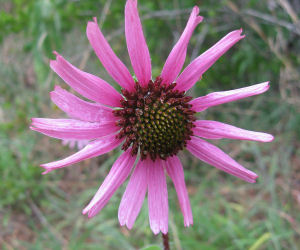
Tennessee State Wild Flower: Tennessee Echinacea
Photograph: Mason Brock (Wikimedia Commons)
As such, the State of Tennessee has no official state "flower." Rather, it counts among its roster of official representatives two official state "wild flowers" and one official state "cultivated" flower. Tennessee echinacea, also known as Tennessee coneflower or purple coneflower, is one of the state's two official wild flowers.
Tennessee echinacea was placed on the endangered species list, by the U.S. Fish and Wildlife Service in 1979. It was only the second plant listed as endangered under the Endangered Species Act. In summary,
The Service determines Echinacea tennesseensis (Tennessee purple coneflower), a native plant of Tennessee, to be an Endangered species. Past and potential loss of this species; habitat due to residential development is threatening the continued existence of the species. Overutilization of this species due to its esthetic and possibly medicinal qualities also poses a threat to this species. This action will provide the species protection provided by the 1973 Endangered Species Act, as amended.
("Environmental Conservation Online System", 1979)
The ruling went into effect on July 9, 1979.
Originally described in 1898, Tennessee echinacea was thought to be extinct for fifty years until botanist Elsie Quarterman "re-discovered the plant in 1969. It is found only in a few places, where the soil is dry and rocky, in the limestone barrens and cedar glades of Middle Tennessee.
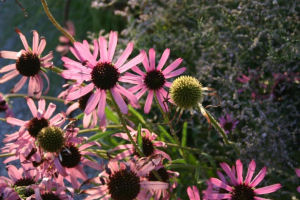
Tennessee State Wild Flower: Tennessee Echinacea
Photograph: Russ Brown
Coordinated efforts were placed behind a major campaign to save the plant, including purchase of critical cedar glades habitat by the Nature Conservancy, re-population from nursery-grown seeds, establishment of new colonies, prescribed land burns, bush-hogging and goats to control competing vegetation.
After over thirty years of attention, Tennessee echinacea (Echinacea tennesseensis) was de-listed on September 2, 2011.
Though still rare in the wild, the Tennessee echinacea population is now considered sustainable and, hopefully, even prone to growth. Healthy colonies can be found in three Middle Tennessee counties; Davidson, Rutherford, and Wilson.
Some of the best places to find Tennessee echinacea are Long Hunter State Park, Cedars of Lebanon State Park, Stones River National Battlefield, and a couple of State Natural Areas, Couchville Cedar Glade and Vesta Cedar Glade.
From endangered species to official state wild flower
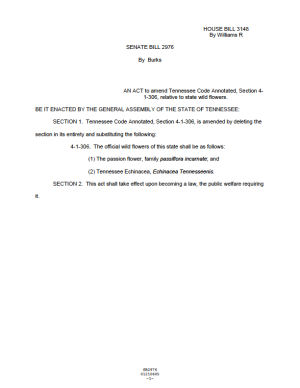
Senate Bill No. 2976

Tennessee State Wild Flower: Tennessee Echinacea
On January 26, 2012, in response to a request from a constituent, Tennessee State Senator Charlotte Burks introduced Senate Bill No. 2976 (SB2976), proposing the Tennessee echinacea (Echinacea tennesseensis) be designated the state's second official state wild flower. A companion bill, House Bill No. 3148 (HB3148), was introduced in the House of Representatives on the same day.
At a hearing of the Senate State and Local Government Committee on February 10, Sen. Burks explained that a constituent had told her that Tennessee echinacea was a flower that was native to the state and had the name of the state in its own name. Sen. Burks also mentioned that it was on the endangered species list. Presumably, this was to enhance the status of the flower and bring an awareness of its special place in Tennessee's natural history. She also passed out pictures of Tennessee echinacea to committee members.
Of course, the Senator's stumbling over pronunciation of the scientific name for the echinacea flower, Echinacea tennesseensis, brought its share of teasing from committee members but all in good fun.
The Tennessee echinacea received a unanimous favorable vote by the committee.
On the floor of the Senate prior to a third and final vote on SB2976, Senator Burks was again chided about pronunciation of Echinacea tennesseensis. Voting on the bill, however, only required simple-to-pronounce single syllable ayes or nays. Senate Bill No. 2976 passed by a unanimous vote of the Senate (31ayes, 0 nays) on February 27, 2012.

Tennessee State Capitol, Nashville
With a smooth ride in the Senate, SB2976 was forwarded to the Tennessee House of Representatives, where it was referred to the House State and Local Government Committee.
Things got a little bumpier in the House, where State Representative Ryan Williams carried the bill for Sen. Burks.
There was some concern about naming a flower that could only be found in only three of Tennessee's ninety-five counties and there was some comment on the value of a second state wild flower
There was also a bit of the unsurprising commentary on pronunciation and spelling of the flower's scientific name.
Actually the pronunciation of the scientific name is quite simple: something like this: Ek-i-na-cia Tennessee-ensis. The Missouri Botanical Garden provides an audio guide.
Additionally, Rep. Williams was berated, tongue in cheek, for being unable respond to a question regarding the number of counties in Tennessee.
In the end, in spite of the reservations of some representatives who weren't sure why we needed a second state wild flower, SB2976 passed with a unanimous vote (94 ayes, 0 nays) in the House on April 9, 2012. SB2976 was substituted for companion bill HB3148 on the same day.
After passage by the Tennessee General Assembly, Senate Bill No. 2976 was forwarded to the Governor for his consideration.
With an inspirational recovery story in its past, the Tennessee echinacea, or Tennessee coneflower, joined the passion flower and became Tennessee's second state wild flower when Governor William Edward "Bill" Haslam signed Senate Bill No. 2976 on April 26, 2012.
PUBLIC CHAPTER NO. 829
SENATE BILL NO. 2976
By Burks, Ford
Substituted for: House Bill No. 3148
By Ryan Williams
AN ACT to amend Tennessee Code Annotated, Section 4-1-306, relative to state wild flowers.
BE IT ENACTED BY THE GENERAL ASSEMBLY OF THE STATE OF TENNESSEE:
SECTION 1. Tennessee Code Annotated, Section 4-1-306, is amended by deleting the section in its entirety and substituting the following:
4-1-306. The official wild flowers of this state shall be as follows:
(1) The passion flower, family passiflora incarnate; and
(2) Tennessee Echinacea, Echinacea Tennesseensis.
SECTION 2. This act shall take effect upon becoming a law, the public welfare requiring it.
This is how this official state wild flower is described in the Tennessee Blue Book 2013-2014:
Tennessee Echinacea, also known as the Tennessee coneflower or Tennessee purple coneflower, became a state wildflower by Public Act 829 in 2012. The wildflower, Echinacea tennesseensis, is one of the few plants that thrives only in the limestone and cedar glades of Middle Tennessee. It was thought to be extinct until it was rediscovered in the late 1960s. Due to conservancy efforts, land was purchased to protect it, and the species recovered. The flower features a daisy-like coneflower with rose-purple petals and a spiny copper-colored center. It generally blooms from mid-spring until mid-autumn.
(Tennessee Blue Book)
All of Tennessee's state flowers are listed here with a timeline illustrating their shifting titles.
Tennessee Law

Tennessee State Wild Flower: Tennessee Echinacea
Photograph: Russ Brown
The following information was excerpted from the Tennessee Code Annotated, Title 4, Chapter 1, Part 3, Section 4-1-306.
Title 4 State Government
Chapter 1 General Provisions
Part 3 State Symbols
Tenn. Code Ann. § 4-1-306 (2015)
4-1-306. State wild flowers.
The official wild flowers of this state shall be as follows:
(1) The passion flower, family passiflora incarnate; and
(2) Tennessee Echinacea, Echinacea tennesseensis.
HISTORY: Acts 1973, ch. 16, § 1; T.C.A., § 4-117; Acts 2012, ch. 829, § 1.
Sources...
Burks, Charlotte. "SB 2976 By Burks." Legislation Archives. Tennessee General Assembly, 30 Apr. 2012. Web. 15 Mar. 2015.
"Determination That Echinacea Tennesseensis Is an Endangered Species." Environmental Conservation Online System. U.S. Fish & Wildlife Service, 6 June 1979. Web. 30 Apr. 2015.
"Flower Once Thought Extinct Will Come Off Endangered List." National Public Radio. 4 Apr. 2011. Web. 30 Apr. 2015.
Furlong, Kara. "Elsie Quarterman, Who Rediscovered Tennessee Coneflower, Dies at 103." Vanderbilt News. Vanderbilt University, 12 June 2014. Web. 17 Mar. 2016.
McCue, Kimberlie, Ph.D. "Echinacea Tennesseensis." National Collection of Endangered Plants. Center for Plant Conservation. Web. 30 Apr. 2015.
Nord, Glynda Joy. Official State Flowers and Trees: Their Unique Stories. Bloomington: Trafford, 2014. Google Books. Web. 29 Apr. 2015.
Simmons, Morgan. "Rare Tennessee Coneflower Makes a Comeback." Knoxville News Sentinel. 4 Aug. 2011. Web. 7 May 2012.
"Tenn. Code Ann. § 4-1-306 (2015)." Tennessee Code Unannotated. LexisNexis, a Division of Reed Elsevier Inc. Web. 17 Mar. 2016.
Tennessee Blue Book. 2013-2014. Tennessee Secretary of State. Department of State Division of Publications. Web. 17 Mar. 2016.
Additional Information

Tennessee's Very Own Coneflower: Article from the Knoxville Botanical Garden.
Echinacea tennesseensis: Brief profile from the Lady Bird Johnson Wildflower Center at the University of Texas, Austin.
Echinacea tennesseensis: Gardening help from the Missouri Botanical Garden A pronunciation of the scientific name is also provided for those lawmakers who might still be interested.
Echinacea tennesseensis (Beadle) Small (Tennessee purple coneflower): Information from the PLANTS Database: U.S. Department of Agriculture's Natural Resources Conservation Service.

Tennessee Purple coneflower (Echinacea tennesseensis): Profile from the U.S. Fish and Wildlife's Environmental Conservation Online System. Includes species status among other things.
Echinacea tennesseensis (Beadle) Small: Integrated Taxonomic Information System (ITIS) Here you will find authoritative taxonomic information on plants, animals, fungi, and microbes of North America and the world.
Echinacea Tennesseensis Flower Seeds: Purchase Echinacea Tennesseensis seeds from Amazon.com. Difficult to grow without proper conditions.
Echinacea tennesseensis Seeds: Seeds from the Baker Creek Heirloom Seed Co., Mansfield, Missouri.
State wildflowers: Complete list of official state wildflowers from NETSTATE.COM
More symbols & emblems: Complete list of official Tennessee state symbols from NETSTATE.COM.

Wildflowers of Tennessee,
the Ohio Valley and
the Southern Appalachians
Dennis Horn
Tavia Cathcart
Thomas E. Hemmerly
Wildflowers of Tennessee, the Ohio Valley and the Southern Appalachians, by Dennis Horn, Tavia Cathcart, Thomas E. Hemmerly. 496 pages. Publisher: Lone Pine Publishing; 2nd Edition (May 6, 2012)
This is the most complete, comprehensive and informative field guide ever published on the flora of this region. Sponsored by the Tennessee Native Plant Society, this labor of love has been 14 years in the making. The result is a landmark achievement that brings the beauty and uniqueness of wildflowers to amateurs and experts alike. The focus is on Tennessee, but the Ohio Valley and Southern Appalachians are covered, encompassing all or parts of Alabama, Arkansas, Georgia, Illinois, Indiana, Kentucky, Maryland, Mississippi, Missouri, North and South Carolina, Ohio, Pennsylvania, Virginia, and West Virginia. 800 color photographs, 96 line drawings, 3 full-color state and region maps.
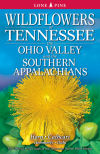
Wildflowers of Tennessee
Jack B. Carman
Wildflowers of Tennessee, by Jack B. Carman. 427 pages. Publisher: Highland Rim Press; 1st Edition (2001)
More than 780 color photographs are included in <çite>Wildflowers of Tennessee, more than in any similar work portraying a state’s flora. Additional species mentioned in the text prove useful in identifying over 1100 of the state’s vascular plants and a majority of the showier non-woody plants. Species descriptions are organized consistently for reference and comparison. Families are arranged phylogenetically and genera within families and species are arranged alphabetically.
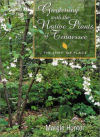
Gardening With The
Native Plants Of Tennessee
Margie Hunter
Gardening With The Native Plants Of Tennessee: The Spirit Of Place, by Margie Hunter. 99 pages. Publisher: University of Tennessee Press; 1st Edition (October 31, 2002)
In Gardening with the Native Plants of Tennessee, Margie Hunter gives gardeners the knowledge they need in order to nurture this natural heritage in their own gardens. Beginning with a survey of the state’s ecology—including geology, geography, plant life and animal species—Hunter takes a holistic approach to the process of gardening with native plants. The book’s main section provides detailed accounts of 450 species of wildflowers, ferns, grasses, vines, shrubs, and trees native to Tennessee and adjacent states. These descriptions, arranged according to plant type, include both scientific and common name, flowering and fruiting times, propagation methods, soil and light requirements, and distribution patterns within the state. Nearly 400 color photographs illustrate the species discussions.
No other book designed for the home gardener includes such area-specific information on native species or such a comprehensive listing of plants. Appendixes refer readers to other sources of information and seeds, including mail-order nurseries, botanical gardens, state agencies, native plant organizations, and subject-specific conferences. A detailed bibliography also contributes to the reference value of this book for gardeners, landscapers, and nature lovers throughout Tennessee and in neighboring states.
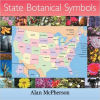
State Botanical Symbols
Alan McPherson
State Botanical Symbols, by Alan McPherson. 132 pages. AuthorHouse (June 10, 2013)
Alan McPherson is a naturalist who resides in northern Indiana and enjoys traveling and learning about the botanical resources our vast country.
In this reference book over 200 state botanical symbols are presented with informative text that highlights their adoptive legislation, botanical and social history. From the white pine of Maine's northeastern forests, westward to the yellow hibiscus of Hawaii's Polynesian islands, our state's official botanical symbols are as uniquely diverse as the terrain and character of the 50 states themselves.
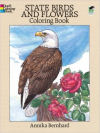
State Birds and Flowers
Coloring Book

U.S. State Flowers
in Counted Cross Stitch
Gerda Bengtsson
State Birds and Flowers Coloring Book
by Annika Bernhard
51 accurately detailed, copyright-free renderings include national bird (eagle) and flower (rose) plus 50 state birds and flowers.
U. S. State Flowers in Cross Stitch
by Gerda Bengtsson - Botanically correct cross stitch designs of state flowers of the 50 States.
Quilting Flowers of the States
by Sue Harvey - A lovely 12-inch flower block for each of the 50 states. Techniques used are piecing, appliqué, paper-piecing and three-dimensional techniques.
Plants, Seeds & Flowers:
Bulbs, seeds, plants, fertilizer, plant containers, garden tools and more.


